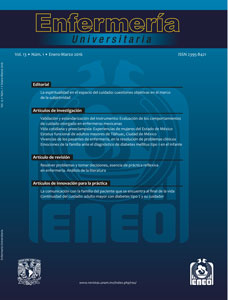Nursing professional communication with the family of the terminal patient
Main Article Content
Abstract
Introduction: The family of the terminal patient is an essential therapeutic element while relieving the patient’s suffering; and thus, nursing professionals should promote that families are prepared, and willing, to provide the necessary companionship to the terminal patient.
Objective: To identify the importance of the communication between the nursing professionals and the family of the terminal patient.
Development: Caring patients and their families requires that nursing professionals develop and strengthen emotional competencies to understand the process of therapeutic communication and implement it in their daily practice.
Conclusion: Nursing professionals should acknowledge that the therapeutic communications in care must develop transversally, and that this process is founded on knowledge, supporting relationship, and active listening. This particular form of listening is essential because it has the purpose to re-establish the family’s emotional stability so that this is re-directed as a therapeutic element which can contribute to relieving the suffering of the terminal patient in his/her last moments. With the above, it will be achieved an improvement in professional skills and communication quality.
Publication Facts
Reviewer profiles N/A
Author statements
- Academic society
- N/A
- Publisher
- Universidad Nacional Autónoma de México
Article Details
Dimensions citation
MÉTRICAS
Enfermería Universitaria by Universidad Nacional Autónoma de México it is distributed under the License Creative Commons Attribution - NonCommercial - NoDerivatives 4.0 International
Accepted and published articles become open-access under the terms of the Creative Commons CC BY-NC-ND 4.0 license, which authorizes the reproduction and sharing without commercial purposes, provided the corresponding acknowledgments to their authors. Authors are allowed to manage a self-archive copy of the article’s published version so that they can open-access it in their personal or institutional web pages, and/or any other broad-diffusion space.


